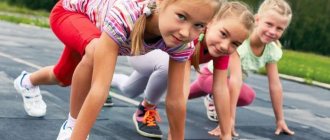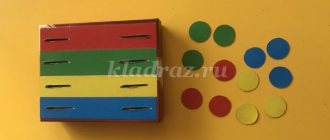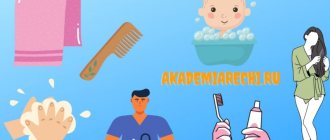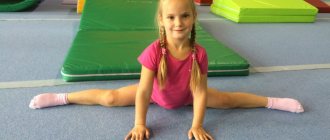Games on the topic: Healthy lifestyle for the younger group of preschool educational institutions
Card index of Didactic games on developing the foundations of a healthy lifestyle for children of the younger group in kindergarten
Description of the material: This material will be useful to educators and parents of children of the younger group.
It is intended to form initial knowledge about a healthy lifestyle. Didactic games and exercises
Game “Vegetables and Fruits”. Objectives: To systematize children’s ideas about the distinctive features of vegetables; Foster a caring attitude towards plants; Develop fine motor skills, memory, speech. Material: Vegetable dummies (cabbage, carrots, cucumber, garlic, potatoes, pepper, corn, tomato), baskets, fruit dummies (apple, pear, orange, tangerine, banana). Progress of the game: Educator: Guys, let's look at what's in the basket. The teacher takes out a basket with dummies of vegetables and fruits and invites them to examine them. Educator: Look, these are vegetables and fruits. Let's put the vegetables and fruits in different baskets. In the vegetable garden, in the vegetable garden we had fun walking. In the vegetable garden, in the vegetable garden we dug up beds. The seeds were planted in the garden bed, they were lowered into the hole, and then the bed was watered with warm water. You grow carrots, peppers and garlic quickly! We will weed the garden bed. Let's pour some water! The teacher reads poems about vegetables and fruits. We sat down at the table, put on our aprons, and we will eat fruit - delicious food. Oh yes pear! What a wonder! And blush and beautiful. The pear begs: “Eat me, Vanyusha, dear apple, ours, in bulk. It will grow in our garden, I will go for it in the fall. Ripe, juicy orange - The first vitamin in fruit. How good he is And how he looks like the sun. Look, watermelon, what a funny little fellow! Solemn and smooth on top, but sweet on the inside. Educator: Well done guys. Complicating the game: Invite children to look at vegetables and fruits and sort them by color. Game “What Grows in the Garden” Purpose: To learn to distinguish vegetables by taste and appearance. Game rule. Take out vegetables and determine their taste by looking at their appearance and touch. Progress of the game: The teacher brings a hedgehog to the group and says: “The hedgehog grew a crop of vegetables in his garden. Hedgehog is a good cook. He decided to make soup. He cut the vegetables, put them in a pan, and then he got a phone call and he was distracted. When the hedgehog returned, he could not remember what vegetables he was cutting on the board. Help the hedgehog identify the vegetables for the soup." The teacher gives the children to try chopped vegetables: carrots, cabbage, turnips. Vegetables can be placed in a deep cup so that children can take the vegetable without seeing it, touch it, and taste it. Game “Gegetable Shop” Purpose: Expand ideas about shape and size, develop skills in comparing objects. Game task: Be good sellers, select the right vegetables for buyers. Game rule: Do not make mistakes when sorting goods, do not anger the hedgehog director. Progress of the game: The teacher invites the children to a new vegetable store. There are a lot of goods on the counter: beets, potatoes, carrots, tomatoes. Offers children to work as sellers in a store. The director of the hedgehog store invites the sellers and gives them the task: to arrange the goods in baskets so that customers can quickly buy them: select round-shaped vegetables into the baskets. If the children are wrong, the hedgehog snorts angrily. Game option. You can invite children to deliver vegetables from the vegetable depot by car to kindergartens and shops (select only red vegetables; pack larger and smaller vegetables). Game “Let's treat the doll to tea” Goals: to repeat the names of tea utensils, the order of setting the table for tea drinking, to give an idea of the rules of safe behavior at the table. Equipment: doll furniture, teaware, doll. Progress of the game: The teacher invites the children to treat the doll with tea, clarifies what kind of dishes are needed, asks to put the saucer, reminds that the cup must be placed with the handle turned to the right, and the spoon should also be placed on the saucer to the right of the cup. He asks questions about what you can drink tea with, offers to put some treats on the table, then invite the doll to the table, treat her to tea, remind her that the tea is hot and she needs to be careful not to get burned. Draws attention to the fact that you should always behave calmly at the table. Game “Putting the Doll to Sleep” Objectives: to consolidate the names of bedding and their accessories; clarify the sequence of undressing and hanging clothes; reinforce the idea that sleep is good for health. Equipment: doll bed with bedding, chair, doll, pajamas or nightgown for her. Progress of the game: The teacher says that it is time to put the doll to bed, asks to make a bed for her, clarifies the procedure for undressing and hanging clothes on chairs, and invites the children to do this. After going to bed, he reminds that children definitely need to sleep during the day and go to bed on time in the evening, as this is all good for their health, and if children sleep well, they grow up faster. To make the doll fall asleep faster, he offers to sing a lullaby for it. Game “What lies where?” Objectives: to consolidate knowledge about the need to maintain order in a group, to clarify knowledge about the arrangement of objects in a group, to consolidate the idea that keeping things in order helps to maintain health. Equipment: subject pictures depicting toys, dishes, clothes, shoes, books, photographs of group furniture, play centers for various types of children's activities. Progress of the game: The teacher examines with the children photographs of group furniture and centers for various types of activities, clarifies their purpose. He lays out photographs on the tables, distributes object pictures to the children and offers to put things in order - to put objects in their places. Exercise “Let's tell Styopka how to behave in kindergarten” Goals: clarify the idea of the rules of safe behavior in a group Equipment: toy Styopka, photographs of group rooms or corresponding pictures. Progress of the game: The teacher brings in a toy, examines it with the children, asks them to remember the content of the cartoon, sequentially shows photographs or pictures, then offers to tell Styopka how to behave in a particular room, while emphasizing safety rules. Exercise “Dressing the doll for a walk” Objectives: to consolidate the names of winter clothes, to clarify the dressing order. Equipment: several dolls, winter clothes and shoes for them. Progress of the game: The teacher offers to dress the dolls for a walk, clarifies what items of clothing are needed, invites the children to take turns putting an item of clothing on the dolls in one or another sequence in which the children dress themselves, encourages them to comment on their actions. Exercise “Let's show Mishka how to dress so as not to catch a cold” Objectives: to consolidate the names of winter clothes and the order of dressing, to form an idea of the need to take care of one’s health. Equipment: Teddy Bear toy, clothes for him. Progress of the game: The teacher shows Mishka, incorrectly dressed for a walk (coat is not buttoned, there is no scarf or mittens, etc.), clarifies whether Mishka dressed correctly for a walk, why not, and offers to tell and show Mishka how to dress. At the teacher’s suggestion, children put on clothes, show and tell why they need a scarf, mittens, etc. Game “Recognize and name vegetables” Objectives: consolidate knowledge of the names of vegetables, learn to recognize them from the teacher’s description, continue to form an idea of the health benefits of vegetables . Equipment: pictures or models of vegetables. Progress of the game. The teacher looks at the pictures and clarifies the names of the vegetables. Then, having removed the visual material, he gives a description of the vegetables one by one according to the following scheme: size, color, shape, smell, taste. When playing the game again, poetic riddles can be used instead of descriptions. Game “Where to Put the Bunny’s Harvest” Goals: to consolidate the general concepts of “vegetables” and “fruits”, to practice the ability to distinguish and name them. Equipment: toy bunny, pictures or dummies of vegetables and fruits, vase, basket. Progress of the game. The teacher says that the Bunny needs to lay out the harvest, but he forgot where to put it, and offers to help him. With the children, he examines the crops that the Bunny has grown, clarifies the names, and suggests putting fruits in a vase and vegetables in a basket. Game “Guess the Taste” Goals: to consolidate knowledge about vegetables and fruits, the ability to identify them by taste, to consolidate the idea of the health benefits of fruits. Equipment: vegetables, fruits that can be eaten raw, pieces of these vegetables and fruits. Progress of the game. After examining the vegetables and fruits, the teacher clarifies which of them to eat raw, suggests remembering the taste of vegetables and fruits and other features (cabbage, carrots are crunchy in the teeth, oranges and onions have a specific smell, an apple is juicy, etc.), reminds them of health benefits. Then he invites you to close your eyes, open your mouth, and one by one puts each person a piece of fruit or vegetable so that the children can identify them according to their taste. Game “Name it Correctly” Goal: to clarify knowledge about vegetables, their qualities (color, shape, taste, smell), consolidate the ability to recognize them from a picture and give a brief description. Equipment: pictures of vegetables and fruits. Progress of the game. The teacher looks at the pictures and clarifies the names of the vegetables. Then, having removed the visual material, he gives a description of the vegetables one by one according to the following scheme: size, color, shape, smell, taste. When playing the game again, poetic riddles can be used instead of descriptions. Game “We have order” Goal: to develop the knowledge that for convenience and safety all objects need to be put back in place, to reinforce the idea of the rules of safe behavior in everyday life, to cultivate a desire to maintain cleanliness and order in the house. Equipment: pictures depicting items of clothing, shoes, dishes, sewing accessories, work tools, pictures depicting a kitchen cabinet, wardrobe, work drawer. Progress of the game: The teacher reminds the children how important it is to put things back in place so that they are easy to find, and it is especially important to properly store dangerous objects - put objects in their places - and offers to arrange object pictures with images of their destinations. Game “Find the Picture” Goal: consolidate knowledge of the names of clothes, improve the ability to differentiate clothes by season. Equipment: pictures of clothes. Progress of the game: The teacher reminds that children wear different clothes in different seasons, offers to choose winter clothes that girls and boys like to wear, clothes that both girls and boys love. Similarly, he gives assignments about summer, spring, and autumn clothing. Game “Tanya woke up” Purpose: to consolidate the knowledge that when coughing and sneezing it is necessary to cover your mouth, practice using a handkerchief. Equipment: doll, handkerchief, individual handkerchiefs. Progress of the game: The teacher brings the doll Tanya, says that she was walking in windy weather, loosely wrapped her scarf around her neck and caught a cold. She imitates that the doll coughs and sneezes without covering her mouth, reprimands her that this is not possible, invites the children to remind and show Tanya what to do when coughing and sneezing. Then the teacher says that the doll needs to wipe its nose, and invites the children to teach Tanya this: take out their handkerchiefs and show how to do it correctly: bring the handkerchief to the nose, pinch one nostril, release the other, then vice versa and fold the handkerchief and put it away pocket. Game “Bathing a doll” Purpose: to consolidate knowledge of toiletries and washing procedures, clarify knowledge about the need to maintain cleanliness of the body, and promote the formation of the habit of neatness. Equipment: doll, bathtub, washing items, towel, pajamas, bed. Progress of the game: The teacher draws the children's attention to the fact that it is time to put the doll to bed, but before going to bed you need to wash it, and invites some children to bring the necessary items, remembers with the children their names and purpose. Then he clarifies what kind of water should be poured into the bath, offers to place the doll in a bath of water, clarifies where to start washing, and offers one of the children to do this. He also suggests washing the rest of the body, drying the doll, putting pajamas on it, putting it to bed, and singing a lullaby. Exercise “How we recognize an object” Purpose: to consolidate knowledge about the role of the senses. Equipment: objects different in shape, touch, smell, pieces of fruits and vegetables. Progress of the game. The teacher reminds the children that each of them has assistants who help them recognize objects, and they do it in different ways. Then he suggests: -find certain objects with your eyes closed, touch the objects and identify them by touch (fur, cold, wet), -with your eyes closed, try and identify vegetables and fruits, -smell and name the object. Each time the teacher clarifies what helped determine its taste and smell. Game “Who can do what” Goal: to consolidate knowledge about the parts of the body and their role for a person, to develop attention, the ability to quickly and correctly answer questions. Equipment: ball. Progress of the game. Children stand in a circle, the teacher throws the ball to each one in turn, asking questions. The child answers the question and returns the ball to the teacher: What can your hands do? What can clouds do? What can your legs do? What can horns do? What can your eyes do? Who knows how to listen to fairy tales? What can your fingers do? What can bunnies do? What can your mouth do? Who will go for a walk with me? Exercise “Remember the movement” Purpose: to improve the understanding of the role of body parts and the need to exercise them. Equipment: pictures of children performing various exercises. Progress of the game. The teacher reminds that when performing different movements, different parts of the body are exercised, shows pictures depicting exercises for the arms, legs, and torso. He clarifies what exactly is being practiced when performing these movements, then shows pictures one by one, offers to remember the movement and perform it.
We recommend watching:
Didactic games with sand for children 3-4-5 years old Games for younger preschoolers on the topic Animals Didactic games for the development of sensory abilities of children from 1 to 3 years old Educational games for children 2-4 years old
Similar articles:
Educational games for children 3-4 years old in kindergarten
Games to develop communication for preschoolers
Outdoor games for children 3-4 years old in kindergarten
Games to develop perception in children 3-4 years old
Games to develop attention in children 3-4 years old
If I got hurt
Didactic games on health necessarily include material that teaches preschoolers first aid skills.
For the lesson, prepare cards depicting methods of treating various injuries. Name the type of wound, and the children must choose the correct cards and arrange them in the order in which they will provide first aid. For example, if you cut your hand, the pictures will be distributed as follows: washing the wound, applying a sterile bandage, going to the doctor.
To keep your teeth healthy
Bad teeth in preschoolers are a common problem. Therefore, it is important to instill in children the rules of oral hygiene.
The healthy lifestyle game is based on the “yes or no” principle. Ask children questions, and they must answer whether this statement is correct and why:
- You need to brush your teeth daily – morning and evening;
- You can take someone else’s toothbrush if you don’t have your own;
- It’s good to eat a lot of sweets;
- After brushing your teeth, you don’t need to wash the brush;
- If you have a toothache, you should immediately go to the dentist;
- nuts can be cracked with teeth;
- Each family member should have their own brush;
- It is healthy to eat raw vegetables and fruits;
- You need to buy a new toothbrush every 3 months.





